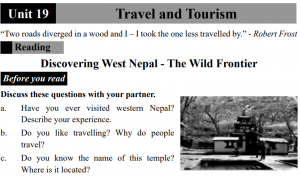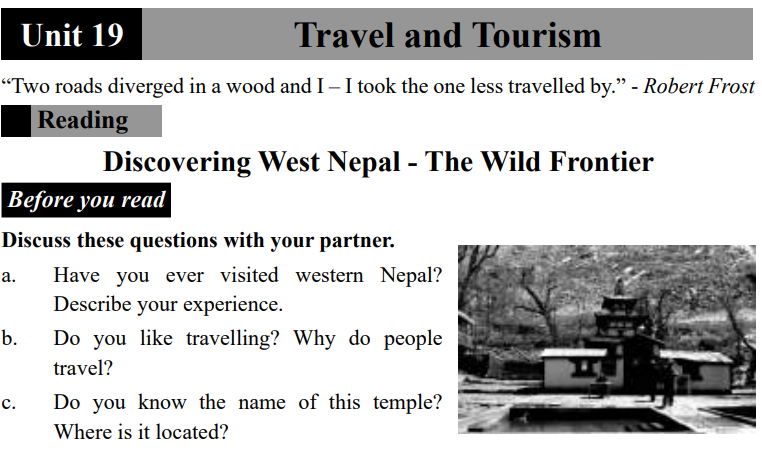Unit 19 Travel and Tourism
Discovering West Nepal – The Wild Frontier

Exercise from the Book:
Ways with words
A. Find the words from the text which mean the following.
a. became fuller and softer by shaking: fluffed
b. sound mental health: sanity
c. consisting of or easily breaking into small pieces: crumbly
d. neither very hot nor very cold: temperate
e. land that does not have enough water to support the growth of plants: arid region
f. only slightly warm: lukewarm
B. Find the meanings of the following words in an English dictionary write their word classes and use them in your own sentences.
hazy frontier lush flipflops altitude fatal magnificent
hazy: not clear/adjective/ It was a very hazy day.
frontier: line that separates two countries/noun/ That was the frontier which was now visible.
lush: covered in grass and plants/adjective/ They glanced around the lush mountains.
flipflops: open shoes/noun/ Rita slipped on undersized flip–flops.
altitude: height above sea level/noun/ During the summer, temperatures are affected by altitude and latitude.
fatal: causing death/noun/ The leader had also a fatal defect in its rules.
magnificent: extremely attractive/adjective/ The magnificent kitchen room is crowded.
Comprehension
Answer these questions.
a. How did the author feel when she saw a colourful rooster in the western Himalayas?
Ans: Her sanity had already gone hazy when she saw a colourful rooster in the western Himalayas.
b. How does she describe the houses on the trails of western Nepal?
Ans: Stone houses held themselves together under a rock, above a river, looking too crumbly to live in.
c. What does she mean when she says “I walked towards a village15 kilometres further as the crow flies?”
Ans: It means the distance she has to cover.
d. Describe the village Thankur in brief.
Ans: Thankur had only two houses. It was an arid region with not much life visible in the periphery.
e. What happened when she reached Jumla and how was she relieved?
Ans: She was ill with an unknown virus and a bad tummy. An American she met at a hotel gave her medicine. The pani puri at a local eatery also helped in her recovery.
f. How does the author describe the bucket water in Khali Lagna?
Ans: The water surface on the bucket was frozen. Cracking it she felt strangely satisfying and the pani underneath was surprisingly lukewarm.
g. How was Rara Lake on the day she reached there?
Ans: Rara Lake was alive and well. Himalaya was there, glistening in its dark blue glory, waiting for her arrival. The magnificent sky-scraping pine trees decorated the ground with giant pine cones. Coots glided over the crystal clear water, occasionally diving under to disappear and resurface again. White peaks said hello from a distance.
Critical thinking
a. It is said that travelling a place equals to reading three books. Do you agree?
Why?
Ans: One of the chief benefits of voyaging is that, it breaks the dullness of life and work. Life, for a great many people, is a distraught surge starting with one spot then onto the next, starting with one action then onto the next, attempting to accumulate however much as could be expected.
In this process, individuals will in general neglect, what their identity is and what they are. There is no an ideal opportunity to consider and ponder. They will in general fail to remember the upsides of life. Voyaging is when individuals unwind, reflect and contemplate. The vast majority, after a charming travel, return home with a new viewpoint, new enthusiasm and a superior determination.
Voyaging has likewise an extraordinary useful worth. It enlarges the grip of our insight into topography, various societies and individuals, and so on For instance, when individuals of Assam visit South India, they gain proficiency with an incredible arrangement. They come to think about the topographical highlights of South India, like the presence of various waterways, coconut forests, backwaters, zest gardens, elastic manors, seas, oceans, production lines, urban communities, and so forth
They additionally learn numerous things about the Dravidian culture which portray individuals’ way of living there. They come to think about their method of carrying on with, public activity, horticulture, love, convictions, fine arts, and so forth Such a visit will undoubtedly illuminate the guest and make him/her more keen to different societies.
Voyaging has an uncommon significance to understudies. A large number of the things they learn in reading material can be basically perceived when they visit different spots. At the point when they visit urban areas, for example, Kolkata, Mumbai, Delhi, and so forth, or the acclaimed lakes, for example, Chilka lake in Orissa, Logtak lake in Manipur, Dal lake in Kashmir, and so on, their grip of geology is developed. Visits to modern focuses, for example, Jamshedpur, Kharagpur, Ranchi, Bangalore, Coimbatore, or significant spots like Cape Comorin, Madurai, Pondicherry, Goa, Kovalam, Cochin, Bhopal, Srinagar, Chandigarh, and so on open their psyches past their reality. Along these lines, voyaging has an incredible scholarly and educational worth. Another critical benefit of voyaging is that it can possibly improve one’s wellbeing.
The magnificence and cold of the slopes, the appeal of the valleys, the tweeting of birds, the melody of the streams, the crying of creatures, wonderful air, calm spots, and so on, can mend large numbers of our psychological and actual issues. In the Indian setting, voyaging and visiting places have another significant worth that of understanding other’s practices and societies.
A visit to different pieces of India will cause us to understand that India is a mosaic of societies, races and belief and that variety is the main sign of our territory. In this unique situation, voyaging can help public reconciliation and solidarity by and large.
Consequently, voyaging has gigantic educative, educational and social worth. It extends individuals’ psychological skyline, improves wellbeing, adds rush and unwinding to life, disperses weariness and helps advancing public incorporation. Along these lines instructive visit should turn into an indispensable piece of current training. Voyaging likewise helps our public economy and the advancement of the travel industry.
b. The author spent five-week long walk along the western Himalayas. Do you think it was adventurous? Why?
Yes, it was adventurous because she had covered a distance that totals up to 25 percent of the Nepal Himalaya via the lower Great Himalayan Trail, along with some funky detours. She experienced places where few tourists go. She chose the Dhaulagiri Circuit. She witnessed and experienced as medieval and raw. She learnt to survive the wild western region with primal instincts, human intuition, and oneness with nature.
She was able to break the monotony of life and work. Life is a mad rush but she became to able to escape it to participate in adventure from one place to another, from one activity to another, trying to gather as much as possible.
Writing
A. Write a travelogue of your recent visit to a natural/religious place in about 300 words. Use the following clues.
| Local costumes and traditions …. Cuisine …Depiction of places of interest, local history and culture …. Your adventures ….. Prices and transportation … Entertainment |
Ans:
Nepal is a landlocked country with full of hidden mysteries. On thursday night, we decided to explore different places of Nepal from Friday. We wanted to explore remote ancient temples, rural cultures and insurmountable peaks. In our seven days travel we explored different valleys, foothills of the Himalayas and wildlife.
On Saturday, we reached Chitwan National Park at 2pm. We explored Nepal’s unique tapestry of flora and fauna in Chitwan National Park. We started trekking in it. We enjoyed the natural playground of elephants and Bengal tigers.
On Suday, we visited the city of Pokhara. It is surrounded by breathtaking scenery. We started a hike through Pokhara Valley that leads us to the crystal waters of Phewa Lake. In the evening, we decided to explore the towering shadow of Machapuchare. We went down to a village to meet the local people. We learn about their indigenous ways of life.
On next day, we decided to fly to Jomsom. It took us 20 minutes from Pokhara to reach Jomsom. We took the two-hour trail to reach village of Thakali. We explored its charming streets and apple orchard. We started the scenic drive from Jomsom to Muktinath. It is located in Muktinath Valley. It is at the foot of the Thorong La mountain pass. It is one of the world’s highest temples.
On next day, we set out on the adventurous trail from Jumla. This trek took us through pine forests, mountain passes, fields and villages. We also enjoyed snow-covered peaks. We Camp overnight in Chhetri villages. On next day, we reach Rara lake. It is the biggest fresh water lake in Nepal. We also enjoyed the beauty of Rara National Park.
We experienced places where few tourists go. We witnessed and experienced as medieval and raw. We learnt to survive the wild regions of Nepal with primal instincts, human intuition, and oneness with nature. After my adventurous travel I realized the importance of saying ‘travelling a place equals to reading three books’.
B. Write an essay in about 500 words on ‘Importance of Tourism in Nepal’.
The travel industry is an assortment of exercises, administrations and ventures that conveys a movement experience, including transportation, facilities, eating and drinking foundations, retail shops, amusement organizations, action offices and other neighborliness administrations accommodated people or gatherings voyaging away from home. It is the biggest industry with yearly incomes of more than $3 trillion dollars in the world. The amount of the wonders and connections emerging from the collaboration of vacationers, business providers, have governments and host networks during the time spent drawing in and facilitating these sightseers and different guests.
Nepal is a little however excellent country. The travel industry can be vital industry for our country. It has the most elevated mountain, Mt.Everest, the consistently streaming Himalayan waterways, glacial masses, huge lakes, green valleys, and dazzling water falls, the public parks in the Terai and Himalayan reach are altogether the attractions for travelers. Lumbini, the origin of Gautam Buddha, can be next fascination.
These all regular assets will be vital for our vacationer industry. The travelers of various types will come to Nepal. Some will comes to see the normal assets, some to examine its chronicled and strict spots.
It’s anything but a great deal of cash to set up different enterprises. Yet, our regular magnificence can be our capital for the travel industry. We can get numerous immediate and roundabout benefits from the travel industry. Above all else, we can begin inns. We can sell our merchandise. Indeed, even ranchers can get opportunity to sell their rural items.
In any case, a few travelers may have criminal nature and perpetrate wrongdoing any time. They may influence our conventional culture. For these all, the security framework ought to be severe and we ought to be much cautious.
It is significant in light of the fact that it set out numerous freedom to our kin who live in metropolitan spots where there are nothing but bad street or no road.If government can give great notice of our country than because of addition of vacationer we can improve our economy.

